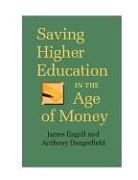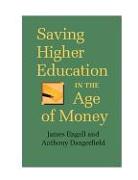- Start
- Saving Higher Education in the Age of Money
Saving Higher Education in the Age of Money
Angebote / Angebote:
Since 1965 an increasing preoccupation with money has resulted in the inversion of its role in higher education, from a practical means to an end that crowds out all others. No longer do students and parents choose the best education that "money can buy." Instead, they are faced with choosing which college or university will "buy them more money." This comes as no real surprise, as the cost of attending a four-year college has doubled since 1985. Yet the question persists: at what real cost are we sending our students to college? Renowned educator James Engell and coauthor Authony Dangerfield explore the answer to this question in Saving Higher Education in the Age of Money. They argue that the counterbalancing attitudes that used to temper a focus on money with other equally legitimate and more fundamental goals have steadily weakened, resulting in a new consensus that elevates money and the marketing of oneself and one's institution to the foremost ambitions of the intellectual world. This new minimization of higher education to the category of an investment to be repaid has damaged all disciplines not directly associated with money, particularly the humanities. Students often now are told they face a choice: between the practical sciences, business, and economic success, or the traditional liberal arts and sciences and expected poverty. In their comprehensive analysis of admission practices, institutional rankings, salaries, hiring practices, scholarships, student attitudes, tuition costs, research programs, library budgets, and class barriers, Engell and Dangerfield expose the major changes that the Age of Money has wrought in higher education while also offering a practical methodof understanding and prioritizing the various elements involved in choosing the right school. Focusing on liberal arts and sciences colleges, private research universities, and flagship public institutions, the authors provide an explicit and coherent model of what an acade
Folgt in ca. 15 Arbeitstagen

